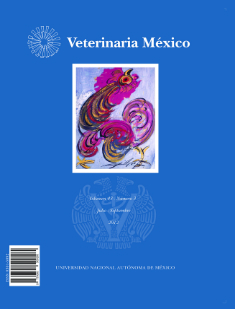Comparative study among Soviet Chinchilla rabbits, an indigenous breed and a black hybrid rabbit under agro climatic conditions of the Meghalaya, India Region.
Main Article Content
Abstract
This work had the aim to meet the demand of local tribal people of the North eastern hills (NEH) region and to evaluate the beneficial heterotic effects of crossbreeding, developing a black-coated rabbit through the crossing of Soviet Chinchilla and indigenous local rabbits, followed by selection and line breeding to maintain the exotic blood level at 50%. Afterwards, a comparative study was done analyzing the different performance traits of Soviet Chinchilla, indigenous local rabbit and the resulting hybrid black rabbits. Data analysis revealed breed-dependent (P < 0.01) effect on all productive traits except on live weight at 60 days. The hybrid black rabbit developed through crossbreeding and line breeding was better than both, the indigenous local rabbit and the Soviet Chinchilla rabbits in terms of live weight at 60, 75 and 90 days of age, live weight gain and average daily gain during 45 to 60 days, 60 to 75 days and 45 to 90 days of age. Overall, mean growth during the period of 45 to 90 days of age in black, local and Soviet Chinchilla rabbits was recorded to be 18.71 ± 0.11, 17.60 ± 0.16 and 16.23 ± 0.21 g per day, respectively. The average air temperature, maximum temperature, minimum temperature and relative humidity during the period of this experiment was 24.44°C, 27.16°C, 16.54°C and 66.16%, respectively. Finally, this research demonstrated that deliberate selection in rabbits leads to improvement in quantitative productive traits.
Keywords:
Productive Performance Rabbit Breeds Health India
Article Details
License

Veterinaria México OA by Facultad de Medicina Veterinaria y Zootecnia - Universidad Nacional Autónoma de México is licensed under a Creative Commons Attribution 4.0 International Licence.
Based on a work at http://www.revistas.unam.mx
- All articles in Veterinaria México OA re published under the Creative Commons Attribution 4.0 Unported (CC-BY 4.0). With this license, authors retain copyright but allow any user to share, copy, distribute, transmit, adapt and make commercial use of the work, without needing to provide additional permission as long as appropriate attribution is made to the original author or source.
- By using this license, all Veterinaria México OAarticles meet or exceed all funder and institutional requirements for being considered Open Access.
- Authors cannot use copyrighted material within their article unless that material has also been made available under a similarly liberal license.



